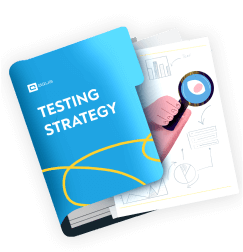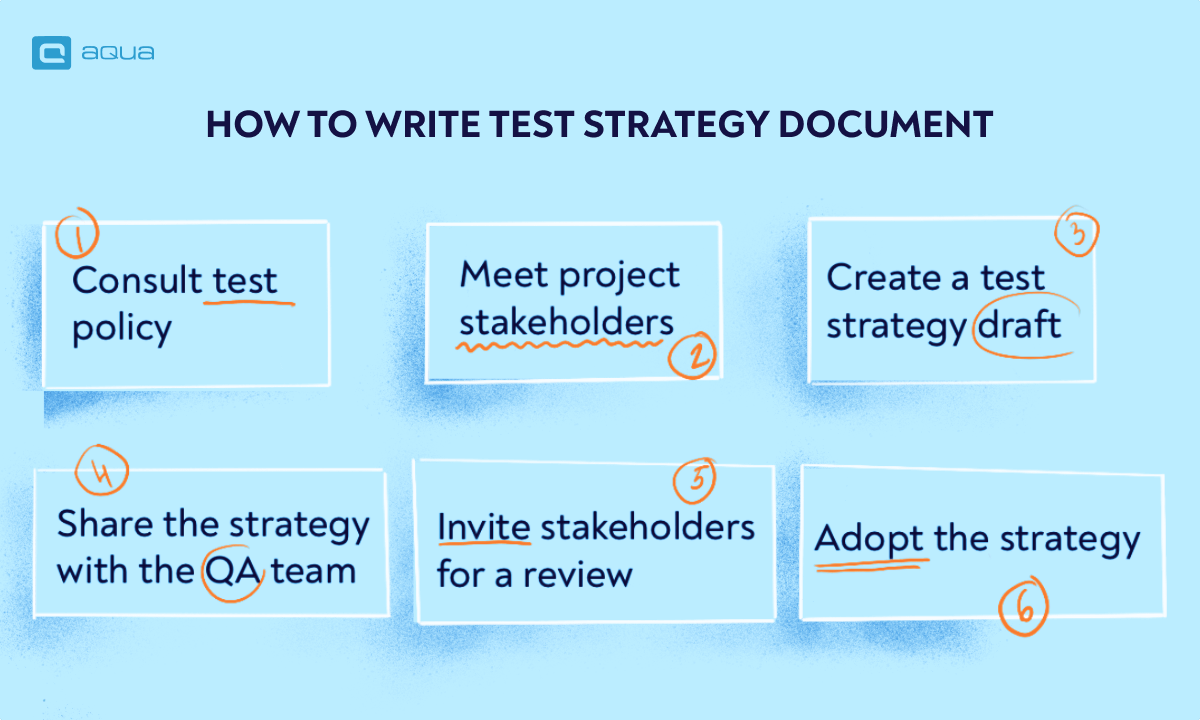What is a testing strategy?
Testing strategy in software engineering is a comprehensive plan or approach that outlines how testing activities will be conducted to ensure the software product’s quality and reliability. The testing strategy defines the testing scope, objectives, and methodologies you will follow to achieve the desired quality. The critical components of a testing strategy typically include the following:
- Scope and objectives: The testing strategy defines the scope, specifying the software areas and functionalities you will test. It also outlines testing objectives, such as identifying defects, validating requirements, ensuring compliance, and measuring the product’s quality.
- Testing levels and types: The strategy outlines various testing levels, including unit testing, integration testing, system testing, and acceptance testing. It also defines the testing types, such as functional, performance, security, and usability.
- Test environments: The testing strategy describes the required test environments for each testing level, including hardware, software, network configurations, and data setups to simulate real-world scenarios.
- Entry and exit criteria: Entry criteria define the conditions your software should meet before testing can commence at a particular level. In contrast, exit criteria define the conditions under which testing is complete for that level.
- Test deliverables: The testing strategy outlines the test deliverables for testing, such as test plans, cases, scripts, data, and reports.
- Defect management: The testing strategy includes defect reporting, tracking, and resolution guidelines, defining the severity and priority of defects, and how you will communicate them to stakeholders.
- Resource allocation: The strategy addresses allocating resources, including people, testing tools, and infrastructure, to conduct the testing activities effectively.
- Risks and contingencies: The strategy identifies potential testing risks and outlines contingency plans to address them. It ensures that risk management is an integral part of the testing process.
- Testing process improvement: Software product testing strategy also includes provisions for continuous improvement of testing based on the learnings from previous projects or feedback received during testing.
Crafting an effective testing strategy requires precision and planning. The smart way to optimise and simplify this process while staying laser-focused on your goals – is to incorporate a comprehensive Test Management System like aqua. Designed specifically for QA specialists and managers, aqua seamlessly integrates into your testing strategy, offering invaluable assistance with:
- Effortless Test Case Management: Benefit from an intuitive interface for streamlined test case structuring and prioritisation.
- Test Traceability: Attain complete visibility with visual test coverage reports and advanced item relations.
- Third-party Integration: Easily integrate with your favourite QA tools, establishing a unified testing environment. No more tool-switching; aqua becomes your central hub.
- Custom Workflows: Tailor aqua to your unique workflow with custom configurations and adapt it to your needs. Not vice versa.
- AI Capabilities: Harness the power of AI to generate test cases from requirements within seconds automatically, prioritise test cases and defects, identify duplicates, generate test data, and much more.
Unleash the power of aqua for unparalleled test case management. With its intuitive interface, you will effortlessly prioritise and structure test cases, saving valuable time and effort.
Here is what you can do with aqua:
- Use AI capabilities to automate tasks, from test case generation to defect prioritisation
- Gain complete visibility through visual test coverage reports and advanced item relations
- Seamlessly integrate with your preferred QA tools, establishing a unified testing environment
- Customise workflows to fit your unique processes
- Harness AI capabilities to automate tasks, from test case generation to defect prioritisation.
Join the thousands of satisfied customers who have witnessed aqua’s transformative impact, freeing up to 32% more time for critical tasks. Elevate your testing strategy and unlock unparalleled speed and accuracy with aqua – the essential tool for modern QA teams.
Turn your testing strategy efforts into a breeze
Test Strategy vs Test Plan
Test strategy and test plan are not the same. Let us repeat — they are not the same!
Test strategy and test plan are two important things you need to create when starting a software testing project. They both have different roles, but they can be used together to achieve a common goal.
The difference between them is that a test strategy is more of an overall outline of the entire testing process — from beginning to end — including deadlines, resources, and other details. It also includes information about what types of tests will be performed and who will perform them. The test strategy is created before any actual testing begins.
On the other hand, test plans are documents that include all of this information and specifics about individual tests, like what kind of data is required for each one or what specific steps need to be followed for them to work correctly (or not).
A test plan is more specific than a test strategy because it contains detailed instructions for carrying out tests on an application or website — tools like scripts or checklists that allow testers to record their findings during each round of testing. So they can compare them later on against previous versions of the same app or site.
Additionally, a test plan tells you exactly how much time each task will take and which tasks need to be done first. For example, if we wanted to create a test plan for software testing, you might write down what you need to do:
- Plan out tests based on what needs to be tested and how many times each feature should be tested before moving on;
- Write up a schedule for when each test should occur, when it should be completed by, where we’ll do it (in-house or at a third-party location), and who’s responsible for completing each task;
- Create documentation explaining how all of these things are going to happen.
So if you’re just trying to figure out what kinds of tests should be performed or how they should be conducted, consider using a test strategy; if you’re planning on creating an actual document with all this information, use a software test plan instead.
But remember, test plans are created after the test strategy has been finalised so that testers know exactly what needs to happen next!
I'd start with working with the dev team and documenting current processes- what level of testing is currently being done? how are bugs currently handled? who determines that feature work is done/ready for release? are tests executed as part of the ci/cd process and does a failing test stop a build from going out? the testing strategy should encompass the entire dev team and sdlc; you can have all of the qa processes in the world laid out but it won't have an affect on the final product if qa is silo'd
Hierarchy of test documentation
As quality assurance makes or breaks business endeavours, it is no wonder that there are different layers to test documentation. QA testing strategy is not at the top of the pyramid, and it’s not something that testers directly interface with either.
The test documentation hierarchy is the following:
- Test policy is the high-level overview that covers the company’s primary goals and principles of testing. It focuses on the business value of QA without diving into any details. Test policy doesn’t undergo changes often, but that is not a problem as it is other levels of test documentation that deal with practical matters
- Test strategy by definition covers at least several projects. It covers enough ground to be a practical guide, e.g. scope of testing, test levels and test types, addressed risks and even methodology for actual tests. Preparing a test strategy is also a great insurance for your new projects, as your staff will have something to work off before going low-level. Test strategy may also have some distilled testing objectives, even more so if there is no test policy in place
- Test plan describes how you as a company can achieve the goals outlined in your test policy and test strategy. This is a per project or even per sprint low-level overview that includes test schedule, the tech stack used for QA (including an on-premise or web-based test case management tool), and project/sprint-specific risks. You can learn more about the overlap between test plan and test strategies in our earlier article.

Get a testing strategy template that enables us to release 2 times faster
How to write test strategy document
When you create strategies for testing, it is important to remember about the business side of things. This is why the QA lead is usually the right person for the job. Here is how it would go:
-
1Consult test policy to see company-wide QA and business principles
-
2Meet project stakeholders to discuss project’s workflows, potential risks, and developer expertise in early testing
-
3Create a test strategy draft (more on that in a test strategy sample below)
-
4Invite stakeholders for a review and amendments
-
5Share the strategy with the QA team to discuss concerns and potential changes
-
6Adopt the strategy and use it

Types of testing strategy
There is a variety of testing strategies, and the choice is not as binary as picking a manual vs automation testing strategy. Here are some examples:
- Methodical strategy deals with pre-requisites like ISO standards
- Consultative strategy involves key stakeholders to help you identify potential risks
- Analytical strategy implies creating tests based on requirements before features were implemented
- Reactive strategy concerns testing after the product was already launched in production
- Regression-averse strategy covers regression risks for updates to both newly developed and in-production software
- Model-based strategy uses a model that simplifies real-life performance of entire software or a system to speed up test execution
Key components of test strategy
A document of a test strategy in software testing typically includes:
- Purpose and Objectives: Clearly defines why the test strategy document is being created and outlines the primary goals and objectives of the testing effort.
- Scope: Specifies what will be tested (e.g., features, modules, integrations) and what will not be tested to set clear boundaries for testing activities.
- Testing Approach: Describes the overall approach to testing, including testing levels (unit, integration, system), testing types (functional, non-functional), and whether testing will be manual, automated, or a combination.
- Test Environment: Details the hardware, software, and network configurations required for testing, including setup, maintenance, and management of the test environment.
- Test Deliverables: Lists the specific documents and artefacts that will be produced during testing, such as test plans, test cases, test scripts, and various test reports.
- Resource Planning: Defines roles and responsibilities within the testing team, identifies necessary skills and training, and outlines the allocation of resources (human and technical) for testing activities.
- Schedule and Milestones: Provides a timeline and schedule for executing testing activities, including key milestones and checkpoints for test planning, execution, and reporting.
- Risk Management: Identifies potential risks that could impact testing activities, outlines mitigation strategies to address these risks, and includes contingency plans for handling unforeseen issues.
- Test Metrics and Reporting: Specifies the metrics that will be used to measure testing progress and effectiveness (e.g., test coverage, defect density) and describes how these metrics will be reported to stakeholders.
- Communication and Collaboration: Defines communication channels and protocols for sharing testing-related information among team members and stakeholders, ensuring transparency and alignment throughout the testing process.
These components ensure that the testing process is well-planned, structured, and aligned with project goals, leading to effective and efficient testing outcomes that contribute to the overall quality and success of the software product.
Example of a good test strategy
As the company providing testing tool for agile software development since 2013, here is what a good agile test strategy template would include:
- Test scope
- Test levels
- Testing tools
- Entry and exit criteria
- Change management
- Environment (e.g. dev, test, prod)
- Compatibility requirements
- Risks
This list is not exhaustive: we’ve listed the main components that an agile test strategy should have. Adding anything extra (such as specifying deliverables) depends on the state of your test documentation and QA maturity. We will be following up on this article with a full-fledged sample test strategy.

Tips to develop successful QA test strategy
- Have a look at test strategy templates available on the internet. They may give you some inspiration even if the described project comes from a completely different industry
- Consult other stakeholders to make sure that the test strategy aligns with the business goals
- Ensure that your test strategy slots well into the test hierarchy. Don’t go too high-level if you have a test policy to lean on. Don’t go too low-level if you know there is a test plan coming as well.
- Find the right QA tools. This is a key part of implementing a test strategy: you need a reliable test management solution with integrations to handle all other QA tools
Your test strategy will benefit greatly from using an innovative test management solution. We suggest aqua, a proven tool that we further enhance with an AI Copilot. You can auto-generate tests, prioritise them, and remove duplicates while using your test suite for context. Automating routine to free time for tasks that need more creativity is an essential piece of any test strategy.
AI testing to give your test strategy wings
5 decisions to make before you create a testing strategy
Why do you even need to make decisions before creating a test strategy? This is a reasonable question.
First of all, sometimes you don’t need to create test strategy. It might be too overwhelming to create a strategy when a product that you are going to verify is too simple for extra documentation.
Secondly, if you decide to go without a test strategy, it is good to have at least some prototype of a test plan. You still need to figure out what kind of test plan is best for your team and whether or not there are any limitations on your budget or time frame.
It’s important that everyone on your team is clear about the project goals and business objectives. This will help ensure that everyone is moving in the same direction and that no one gets left behind.
Once all those pieces are in place, and everyone knows what they’re doing (and why), it’s time to create an actual plan! This plan should include things like deadlines and milestones so that everyone involved knows what’s expected from them at all times during the project lifecycle (i.e., from concept through implementation).
Only when all criteria mentioned above are taken into consideration, you can finally go to these five decisions you should make towards preparing for a test strategy:
- Decide what you’re testing;
- Decide who’s going to test it;
- Decide when the testing will begin and end;
- Decide how you’ll report the results of your tests;
- Decide what is the criteria when your software is ready for release!
Once those are taken care of, it’s time to create your software test strategy!
Conclusion
Testing strategy is arguably the most crucial piece of the test documentation hierarchy. It connects business objectives with the practicalities of quality assurance to drive company-based and project-based testing efforts. A good testing strategy requires an experienced QA lead and good communication with other stakeholders to tailor the best practices to your project.
Flexible solution for any testing strategy







